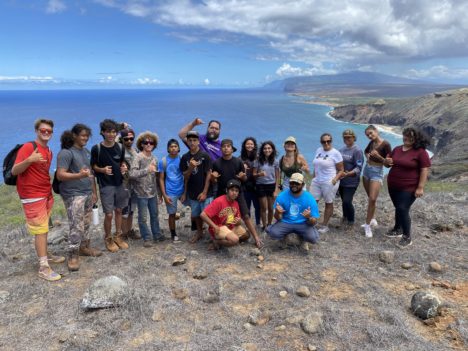Students Help Restore Dryland Forest
By Sage Yamashita, Intern Reporter

Photo courtesy of Ali Lucas.
High school students are working with local nonprofit Molokai Land Trust to replant dryland forests on the island’s northwest side. Molokai High School’s Natural Resource class has been volunteering since September, and their work isn’t done. They have committed to volunteer every month till December to help reach the goal of reintroducing over 8,000 native Hawaiian dryland forest plants into their natural environment.
The Kawakiu Watershed Restoration Project is 7.25 acres based at the Mokio Preserve. The first 2.25-acre plot was built in 2010 and planted from 2011 to 2015. It has 95 percent Native Hawaiian plants and is fenced to keep deer and cattle out. Now the land trust is working on installing a total of 8,712 plants in the second five-acre plot.
“So far this year, 2022, we have planted 3,982 plants in this area,” said Ali Lucas, programs manager at Molokai Land Trust. “We have a total of 5,961 left to plant.”
MHS science teacher Emilio Macalalad has taken his natural resource class to Mokio for field trips before. But this particular class decided they wanted to take it a step further and put in the time every month to replant. The class has planted a total of 249 plants. In September, they planted 100 plants, and in October, they planted 149 plants.
“…It started off as a regular field trip learning how to plant the native plants, but then we heard that they needed to plant thousands of native plants by the end of this year,” said MHS junior Mathew McGuire. “So we decided to plan a field trip once a month to help plant more native plants.”
The students spend their time planting a variety of plants. These include Pua Kala, ‘Ilie’e, Aweoweo, A’ali’i, Mao, Kului, Akia, Wiliwili, Nail and Iliah. They don’t only spend their time in the area planting but also learning why it’s crucial to replant this dryland forest.

Photo courtesy of Ali Lucas.
“I learned about the effect of wind erosion and how the native plants have adapted to the area to help everything stay in balance,” said senior KiraKai Yamazaki-Gray. “Without the plants, the reefs and ocean are getting polluted with dirt runoff.”
The land where the Kawakiu Watershed Restoration Project is located is highly affected by wind erosion. Dirt held by the sparse plants and concerning dry conditions. The students have become valuable in helping reach Molokai Land Trust’s objective of restoring a functional native dryland forest ecosystem that will reduce erosion, increase aquifer recharge and provide habitat and forage for common and endangered native plants and wildlife.
For the next volunteer trip, the students have been given the goal of 1000 plants.
“While the students and volunteers are out there, they need to understand that they need to come with a good mindset because your intentions stay in the ‘āina where you worked,” said Yamazaki-Grey.
Molokai Land Trust also invites the community for community work days. Volunteers can register at Re-Tree Hawaii, retree-hawaii.org/planting/sites/. The next set dates will be Nov. 10 and Nov. 18, both days from 7:30 a.m. to 3 p.m.
“While volunteering, you get to learn how to plant the different native plants and take care of them so in the future you may even have that kind of job or have your own farm,” said McGuire.











Don't have a Molokai Dispatch ID?
Sign up is easy. Sign up now
You must login to post a comment.
Lost Password